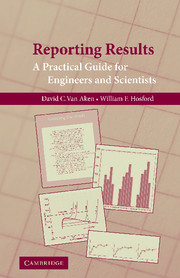Book contents
- Frontmatter
- Contents
- Preface
- REPORTING RESULTS
- 1 Elements of Technical Writing
- 2 Technical Papers
- 3 Technical Letters
- 4 Oral Presentations
- 5 Presentation of Technical Data
- 6 Statistical Analysis of Experimental Data
- 7 Resumé Writing
- Appendix I COMMON ERRORS IN WRITING
- Appendix II PUNCTUATION
- Appendix III COMMON WORD ERRORS
- Appendix IV INTERNATIONAL SYSTEM OF PREFIXES AND UNITS
- Appendix V THE GREEK ALPHABET AND TYPICAL USES
- Appendix VI STRAIGHT-LINE PLOTS FOR SOME MATHEMATICAL FUNCTIONS
- References
- Index
3 - Technical Letters
Published online by Cambridge University Press: 05 September 2012
- Frontmatter
- Contents
- Preface
- REPORTING RESULTS
- 1 Elements of Technical Writing
- 2 Technical Papers
- 3 Technical Letters
- 4 Oral Presentations
- 5 Presentation of Technical Data
- 6 Statistical Analysis of Experimental Data
- 7 Resumé Writing
- Appendix I COMMON ERRORS IN WRITING
- Appendix II PUNCTUATION
- Appendix III COMMON WORD ERRORS
- Appendix IV INTERNATIONAL SYSTEM OF PREFIXES AND UNITS
- Appendix V THE GREEK ALPHABET AND TYPICAL USES
- Appendix VI STRAIGHT-LINE PLOTS FOR SOME MATHEMATICAL FUNCTIONS
- References
- Index
Summary
Technical letters are used for communicating scientific or engineering results that are limited in scope. The letters may describe a single experiment or investigation of which the results need to be rapidly communicated. Technical letters are a common form of communication for engineers or scientists in industry. Technical letters can also be used for undergraduate laboratory report writing in which a less formal presentation is appropriate. This chapter describes the organization and basic format of a technical letter. Two examples of letter reports are given at the end of the chapter.
Organization
Organization of the letter should begin with why the letter is being written, conclusions of the investigation, and what actions the recipient needs to address. This first paragraph is sometimes called an action summary. The body of the letter should support the conclusions and recommended actions. The letter can be organized into three levels of presentation. At the first level, the first paragraph and the figures provide the necessary information to understand the conclusions and recommendations of the investigation. Figure captions must be informative and summarize the findings presented in the figures. At this level, a supervisor can ascertain with minimal reading the major findings of the investigation. The body of the letter should provide greater depth. There should be a summarizing paragraph at the end of the letter. Appendices, where calculations, derivations, and special test procedures are presented, constitute a third portion. Information in the appendices should be supplemental and referenced in the text.
Information
- Type
- Chapter
- Information
- Reporting ResultsA Practical Guide for Engineers and Scientists, pp. 26 - 40Publisher: Cambridge University PressPrint publication year: 2008
